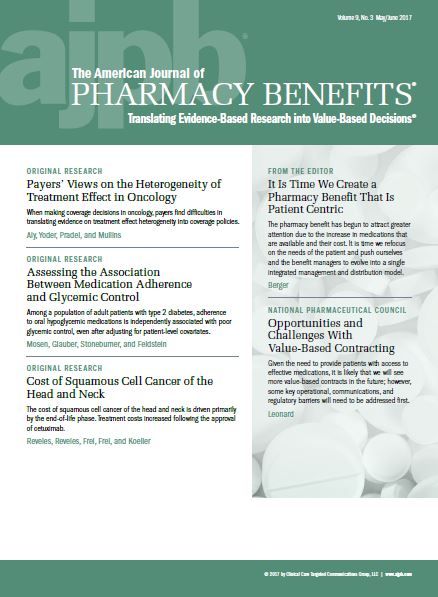Publication
Article
AJPB® Translating Evidence-Based Research Into Value-Based Decisions®
Opportunities and Challenges With Value-Based Contracting
Author(s):
Given the need to provide patients with access to effective medications, it is likely that we will see more value-based contracts in the future; however, some key operational, communications, and regulatory barriers will need to be addressed first.
We are in the midst of a massive shift when the government, private sector, and all stakeholders within healthcare are trying to move us from a system based on reimbursing for the volume of services to one that is pinned to the value of those services.
One component of this shift in the pharmaceutical arena is the practice of developing value-based contracts, under which biopharmaceutical manufacturers and payers agree to link coverage and reimbursement levels to a drug’s effectiveness and/or how frequently it is used.
To date, in the United States, value-based contracting activity has been limited; however, the desire to ensure patient access to important treatments is driving interest in agreements among both payers and biopharmaceutical manufacturers, and our changing healthcare environment may generate more activity in this arena in the future. Nevertheless, activity could remain limited unless we address several operational barriers, as well as regulatory and communications concerns.
Compelling Reasons to Engage in Value-Based Contracting
There are convincing arguments for manufacturers and payers to both consider value-based contracts: 1) manufacturers can use value-based agreements to differentiate and demonstrate the effectiveness of their product versus their competitors, which can assist payers in making formulary decisions; 2) payers can use these agreements to gain experience with a product, reducing uncertainty regarding clinical value, performance and financial impact.1
There are a variety of agreements that have been struck between payers and manufacturers. Although most are based on providing discounts to payers if the drug does not meet a particular clinical endpoint, the contract details are all different. In one agreement, for example, Novartis will provide Harvard Pilgrim with a discount if its heart failure drug Entresto does not provide a given level of reduction in hospitalizations for congestive heart failure.2 In another example, Cigna reached independent agreements with Sanofi and Amgen for their PCSK9 inhibitor drugs, but they share the same overall objective.
According to the agreement, “[i]f Cigna’s customers aren’t able to reduce their [low-density lipoprotein cholesterol] LDL-C levels at least as well as what was experienced in clinical trials, the 2 biopharmaceutical companies will further discount the cost of the drugs. If the drugs meet or exceed expected LDL-C reduction, the original negotiated price remains in place.”3
At the same time, Eli Lilly and Company and Anthem have forged a partnership to begin a public dialogue about ways to move toward an “environment conducive to allowing health plans and manufacturers to enter into a variety of value-based contracting arrangements, aligned with the shift toward value-based payment and the goal of promoting access to high-value care.”4
Challenges With Structuring and Implementing Value-Based Contracts
There are many difficulties inherent in implementing value-based contracts, particularly those based on particular outcomes or indications of a drug. These fall into 3 main areas: operational, communications and regulatory.
Operational issues. Significant payer and provider infrastructure is necessary to monitor an outcomes-based agreement. For example, payers may not have the capability to monitor and track pharmaceutical usage and outcomes relevant to the contract due to a lack of a robust information technology, data infrastructure, or staff expertise, among other issues.
Without proper tracking mechanisms in place, it can be difficult to ensure medication adherence. Manufacturers are reluctant to accept financial consequences when they cannot control how a drug is prescribed or used. In addition, agreeing on outcomes that are meaningful and measurable within a reasonable timeframe is challenging.
Communications concerns. Payers may be interested in lowering expenditures for a particular patient population, such as reducing hospital visits and costs. Yet, this type of clinical or economic outcome might not be included on a drug’s label, which must be approved by the FDA.
As a result, payers and manufacturers cannot agree to a contract based on an outcome that is not listed on the drug’s label, even if strong data exists for that outcome, and this limits their ability to effectively share risk. FDA is currently reviewing how it regulates the exchange of information between payers and manufacturers, so this concern could be addressed in the near term.5
Regulatory barriers. Medicaid Best Price was enacted as a way to keep federal spending in check and guarantee that Medicaid is getting the lowest price that the manufacturer can afford to sell it, which is roughly one-fourth of a drug’s average manufacturer price.6
Manufacturers are reluctant to develop value-based contracts that might result in an effective greater discount than Medicaid Best Price, because the lower “discount” or price would apply not only to the population in the agreement, but to the entire Medicaid population as well.
Fear of inadvertently running afoul of the federal anti-kickback statute, which prohibits the exchange or offer of anything of value in an effort to reward the referral of business, is another reason some manufacturers and payers shy away from value-based contracting.
Value-added services could include activities such as nurse coaches, case management support or adverse event monitoring, all of which have benefits in the administration of a value-based contract. The federal government would need to provide clarity to address this situation.
Potential for the Future
Given the need to provide patients with access to effective medications, it is likely that we will see more value-based contracts in the future. This expansion could be fueled by: 1) improved data systems, which can help create the mechanisms to monitor patient usage of biopharmaceuticals and their effect on health outcomes, and 2) the changing of incentives within the healthcare system toward value-based orientations.
The increased use of accountable care organizations, for example, may lead to enhanced health system alignment with value-based agreements. Yet for value-based contracts to truly take off, we will need to address some key operational, communications and regulatory barriers sooner, rather than later.
Author Affiliations: National Pharmaceutical Council, Washington, DC.
Funding Source: National Pharmaceutical Council.
Author Disclosures: Mr Leonard is an employee of the National Pharmaceutical Council, an industry-funded health policy research group that is not involved in lobbying or advocacy, and an officer of the Board of National Pharmaceutical Council.
Authorship Information: Concept and design (DL); drafting of the manuscript (DL); critical revision of the manuscript for important intellectual content (DL); and supervision (DL).
Send Correspondence to: Dan Leonard, MA, President, National Pharmaceutical Council, 1717 Pennsylvania Ave, NW, Washington, DC 20006. E-mail: [email protected].
REFERENCES
1. Garrison LP, Carlson JJ, Bajaj PS, et al. Private sector risk-sharing agreements in the United States: trends, barriers, and prospects. Am J Manag Care. 2015;21(9):632-640.
2. Pay-for-performance deal with Novartis [press release]. Wellesley, MA: Harvard Pilgrim HealthCare; June 27, 2016. https://www.harvardpilgrim.org/public/news-detail?nt=HPH_News_C&nid=1471911695877. Accessed May 4, 2017.
3. Cigna’s two new value-based contracts with pharma for PCSK9 inhibitor cholesterol drugs tie financial terms to improved customer health [news release]. Bloomfield, CT: Cigna; May 11, 2016. https://www.cigna.com/newsroom/news-releases/2016/cignas-two-new-value-based-contracts-with-pharma-for-pcsk9-inhibitor-cholesterol-drugs-tie-financial-terms-to-improved-customer-health. Accessed May 4, 2017.
4. Eli Lilly and Company; Anthem. Value-based contracting arrangements. Eli Lilly and Company website. https://lillypad.lilly.com/WP/wp-content/uploads/LillyAnthemWP2.pdf. Published January 29, 2016. Accessed May 4, 2017.
5. Drug and device manufacturer communications with payors, formulary committees, and similar entities—questions and answers; draft guidance for industry and review staff; availability. Federal Register website. https://www.federalregister.gov/documents/2017/01/19/2017-01011/drug-and-device-manufacturer-communications-with-payors-formulary-committees-and-similar. Published January 19, 2017. Accessed May 4, 2017.
6. Sachs R, Bagley N, Lakdawalla D. Value-based pricing for pharmaceuticals in the Trump administration. Health Affairs blog website. http://healthaffairs.org/blog/2017/04/27/value-based-pricing-for-pharmaceuticals-in-the-trump-administration/. Published April 27, 2017. Accessed May 4, 2017.







